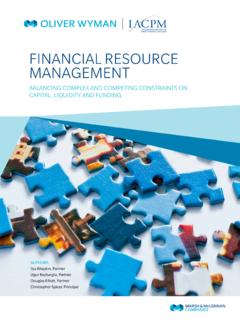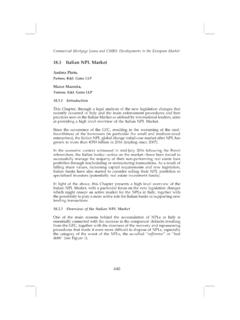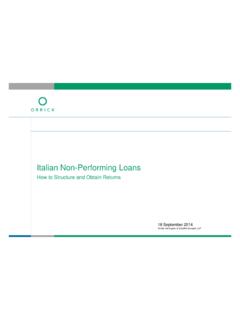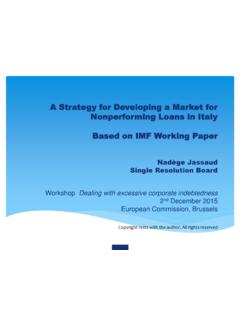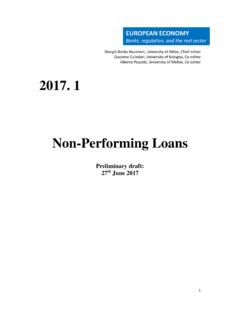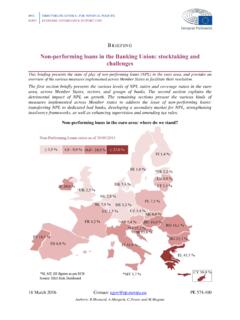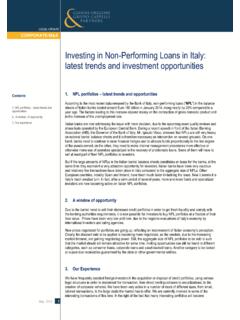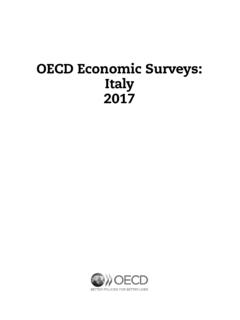Transcription of EUROPEAN RETAIL AND SME CREDIT RECOVERY TIM E? - …
1 EUROPEAN RETAIL AND SME CREDIT RECOVERY TIME?QUALIFICATIONS, ASSUMPTIONS AND LIMITING CONDITIONSN either Oliver Wyman nor Intrum Justitia shall have any liability to any third party in respect of this report or any actions taken or decisions made as a consequence of the results, advice, or recommendations set forth opinions expressed herein are valid only for the purpose stated herein and as of the date hereof. Information furnished by others, upon which all or portions of this report are based, is believed to be reliable but has not been verified.
2 No warranty is given as to the accuracy of such information. Public information and industry and statistical data are from sources Oliver Wyman and Intrum Justitia deem to be reliable; however, no representation as to the accuracy or completeness of such information is responsibility is taken for changes in market conditions or laws or regulations and no obligation is assumed to revise this report to reflect changes, events or conditions, which occur subsequent to the date SUMMARY 51. INTRODUCTION Purpose Approach and Methodology Scope Reflections on previous report 92.
3 CURRENT STATE OF THE EUROPEAN RETAIL CREDIT market market size market penetration Non-performing loans Country categorization Case study: How Spanish banks realised value from their NPL portfolios 213. ONGOING CHANGES TO THE market Regulation Consumer protection Updated financial reporting standards IFRS 9 Stress testing Forbearance and non-performing exposures Digital innovation Improved data analytics to support underwriting decisions Digitalization of the SME offering Broker channel Case study: The UK consumer finance market New competition Case study: Marketplace lending and peer-to-peer lending Using 3rd parties to extract value from distressed portfolios 364.
4 CONCLUSIONS 38 APPENDIX: RETAIL CREDIT MANAGEMENT BEST PRACTICE 40 Targeting 40 Application and Underwriting 42 Customer management 43 Collections 44 APPENDIX: REFERENCE TABLES FOR KEY MACROECONOMIC VARIABLES 45 IN THE BASELINE AND ADVERSE SCENARIOS OF THE EBA STRESS TEST 3 EXECUTIVE SUMMARYS ince the previous Intrum Justitia and Oliver Wyman report in 2008, RETAIL and SME CREDIT markets across Europe have been hard hit by the banking and government debt crises.
5 New lending and growth stagnated across developed EUROPEAN countries, though signs of RECOVERY are now emerging. Non-performing loans are a significant ongoing issue, particularly in Southern EUROPEAN observe four key trends that will change EUROPEAN RETAIL and SME CREDIT markets:1. New regulations covering accounting rules (particularly IFRS 9), Single Supervisory Mechanism, capital and liquidity minima, consumer protection and corporate structures are increasing funding and operational costs and will potentially reduce revenues2. Digital channels are providing opportunities for lower costs, improved targeting and more interactive data capture when underwriting3.
6 Increased use of 3rd party servicers is enabling banks to extract greater value from their portfolios, particularly in distressed markets4. New entrants, in the form of retailers, digital innovators and P2P lenders, are challenging existing players and increasing competition. In parallel, many banks have focused on extracting value from their existing customer base, rather than enlarging itThe characteristics of successful lenders will depend on the markets in which they operate: In distressed markets, winners will be lenders with tools and processes that successfully extract value from their non-performing loan portfolios In developed and emerging countries, success will be based on balancing the core competencies of Marketing, Risk Management and Technology to ensure that lessons from the financial crises are incorporated into new practices Across all markets, lenders will need to adapt rapidly to new regulations, changing product structures.
7 Risk data management and customer communications in ways that preserve profitability 51. INTRODUCTION1. 1. PURPOSEO liver Wyman and Intrum Justitia collaborated to write this report. Oliver Wyman is a global leader in Financial Services consulting, with vast experience across the entire CREDIT value chain. Intrum Justitia is a EUROPEAN leader in CREDIT Management Services, including portfolio purchasing, with a substantial business in RETAIL financial services 2008 Oliver Wyman and Intrum Justitia published EUROPEAN RETAIL CREDIT Payback time?
8 , which assessed the outlook for various EUROPEAN RETAIL CREDIT markets. Seven years on, we felt the time had come for an updated report, especially given the major changes the market has undergone since the financial year s report examines the current state of RETAIL as well as SME CREDIT markets in different EUROPEAN countries and forecasts their evolution over the coming years. We also outline the strategies that banks should adopt in response to these likely changes and look at the capabilities that they will need to APPROACH AND METHODOLOGYO liver Wyman and Intrum Justitia have conducted research and built models for each EUROPEAN country within scope.
9 Data was drawn from a wide range of publicly available sources, including the EUROPEAN Central Bank, National Central Banks, OECD, official national data agencies, published reports and press analysis focuses on loan volumes and loan loss rates by country and asset class (mortgages, personal loans and SME loans). The projections for loss rates reflect the results of the EU-wide stress test that were published by the EUROPEAN Banking Authority (EBA) in October objective of the EU-wide stress test was to assess the resilience of financial institutions in the EUROPEAN Union to adverse market developments.
10 The exercise aimed at ensuring consistency and comparability of the outcomes across all banks based on a common methodology, scenarios and accompanied by a consistent disclosure exercise. 6 The test was conducted on a sample of 124 EU banks which cover at least 50% of each national banking sector. In this report we have not adjusted overall market results to account for skews in the CREDIT performance of institutions not covered by the EBA exercise, (Spain, Germany and Italy have a significant tail of institutions, not covered by the EBA) although we recognise that some skews may exist.







